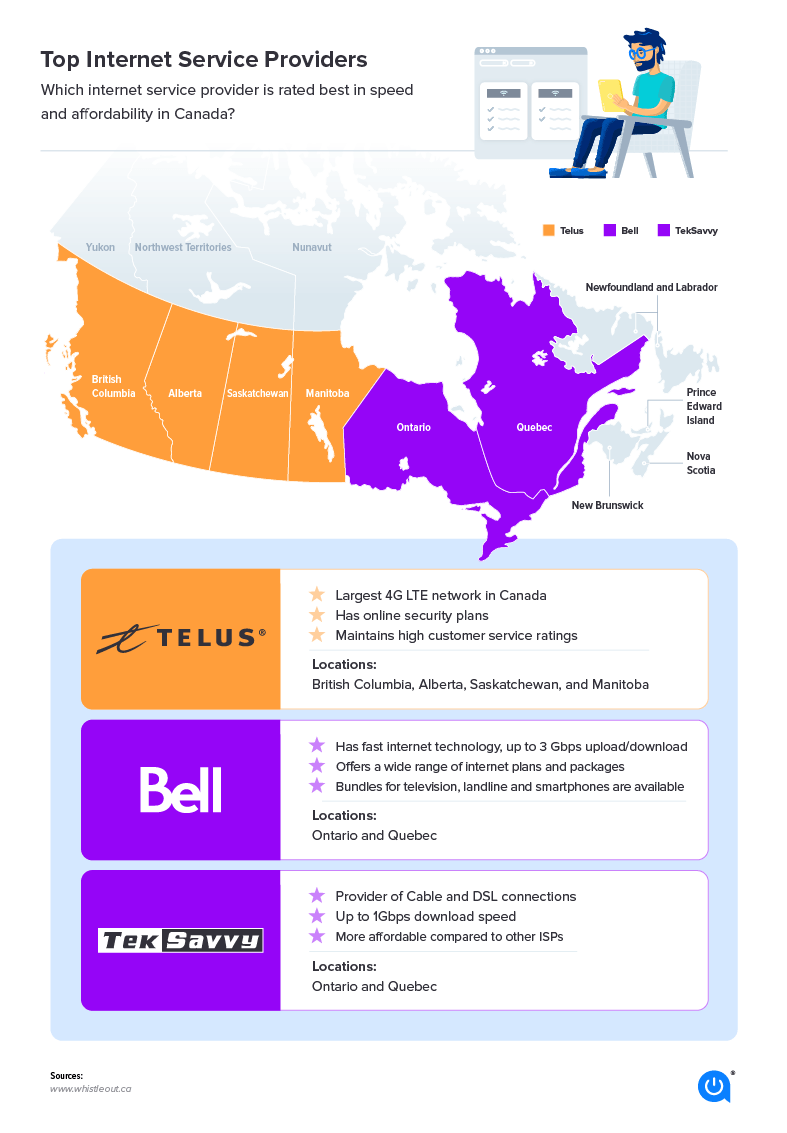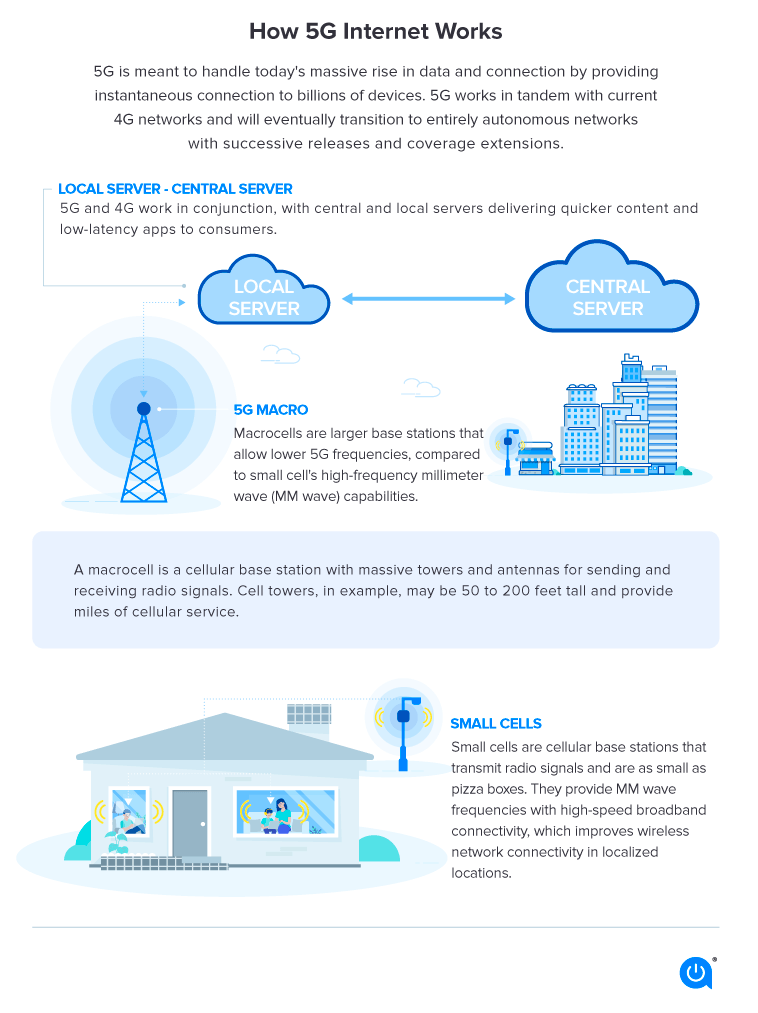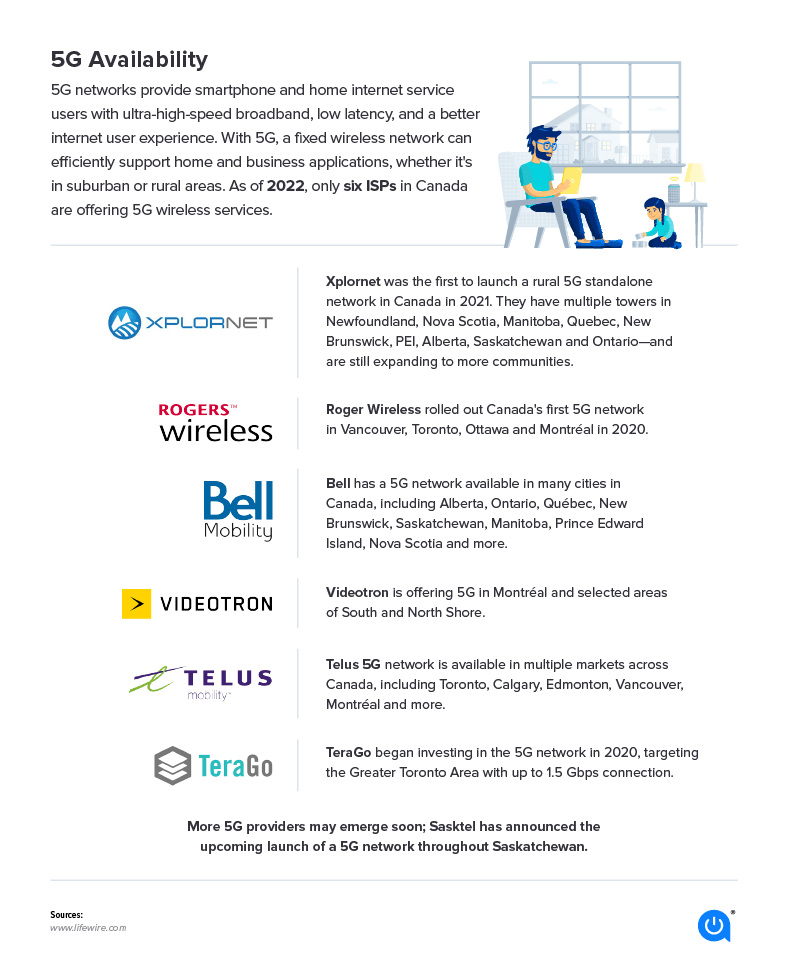Canada has nearly 37 million internet users, or 96.5% of the country, according to Statista. The country’s internet service is regulated by the Canadian Radio-Television and Telecommunications Commission.
Types of internet in Canada
Much like the U.S., Canada offers the typical internet connections of DSL, cable, satellite and fiber. The top internet service providers are Telus, Bell and Tek Savvy. Telus covers much of the country from British Columbia to Manitoba, with Bell and Tek Savvy covering Ontario and Quebec. Also, like the U.S. market, they can bundle services for TV and landline or mobile phones with their internet plan.


How to set up your internet connection
Getting your internet connection up and running is as easy as these three steps:
1. Compare providers and plans
Determine the internet speed that you require and the available service providers who can cater to your needs. Examine bundle deals, contract lock-ins and service reviews to get the best plan for you.
2. Make an order
Call your preferred provider to reserve a date to have your internet service installed.
3. Set it up
Your provider may give you the option between contactless installation or professional installation. A professional installation requires a provider representative to visit your location to set up your internet for you.

The future of the internet in Canada
The Canadian government is committed to “connecting 98% of Canadians to high-speed Internet by 2026 and all Canadians by 2030.”
High-Speed Access for All: Canada’s Connectivity Strategy is the government’s plan to ensure that the rural and remote areas in Canada stay connected to create stronger and more resilient communities with its three pillars:
- High-Speed Access for All – by working with partners to achieve universal 50 Mbps download and 10 Mbps upload speeds for all Canadians.
- Investing for Impact – by investing $1.7 billion for broadband infrastructure and by supporting connectivity projects through the Canada Infrastructure Bank for the next 10 years
- Partnering for Progress – by continuing to engage with Canadians and all other stakeholders and by establishing an expanded Centre of Expertise to improve broadband connectivity
Did you know?
- A 2021 study showed 3 in 10 Canadian families didn’t have access to online school at home due to financial issues.
- The Universal Broadband Fund aims for 100% of the country to have internet access by 2030.
What about 5G?
5G internet service is rapidly expanding in Canada, as announced on PCmag.com, “The three Canadian carriers just launched their 3.5GHz 5G in June … the new 3.5GHz mid-band 5G is a far greater transformation of 5G than Canadians had seen previously. Although the 2020-2021 5G rollouts generally added a small amount of spectrum so the networks could qualify as 5G, this year’s rollout in some cases doubles the amount of airwaves carriers are using, for vastly better speeds and capacity.”


Low-income internet resources
Here are just some of the few ways to access free or low-cost internet access in Canada:
- Connecting Families Canada – helps connect eligible Canadian households to the internet by distributing 500,000 computers
- Computers for Success Canada – a non-profit organization that supports digital inclusion
- Internet for Good by Telus – provides high-speed internet packages for $10/mo.

Did you know?
Shaw and Telus operate free Wi-Fi hotspots (even to non-subscribers) all around the country. Shaw provides over 100,000 hotspots in cafes, stores, restaurants and gyms, with an interactive map to find the one closest to you. .
Telus offers a free service at places like stadiums, airports, cafes, restaurants and malls. The company offers a locator tool and an app to help find the spots.
Click here to download the full graphic for this article.
Written by:
Robin LaytonEditor, Broadband Content
Robin Layton is an editor for the broadband marketplace Allconnect. She built her internet industry expertise writing and editing for four years on the site, as well as on Allconnect’s sister site MYMOVE.com. …
Read more

Edited by:
Joe SupanPrincipal Writer, Broadband Content
-
Featured
![10 questions you should ask before choosing an internet service]() 10 questions you should ask before choosing an internet service Ari Howard — 7 min read
10 questions you should ask before choosing an internet service Ari Howard — 7 min read -
Featured
![Streaming vs. cable: Which TV service is better?]() Streaming vs. cable: Which TV service is better? Camryn Smith — 5 min read
Streaming vs. cable: Which TV service is better? Camryn Smith — 5 min read -
Featured
![Digital divide: Organizations that are helping bridge the gap]() Digital divide: Organizations that are helping bridge the gap Joe Supan — 5 min read
Digital divide: Organizations that are helping bridge the gap Joe Supan — 5 min read
Latest
-
Thursday, July 25, 2024
Worried about losing your signal? This is how to keep your satellite dish cleanDavid Anders — 6 min read
-
Tuesday, July 23, 2024
The best free TV and movie streaming services 2024Camryn Smith — 5 min read
-
Tuesday, July 23, 2024
Everything you need to know about internet speedsRobin Layton — 8 min read






